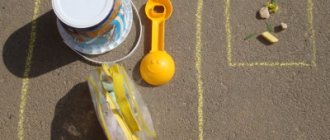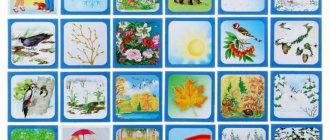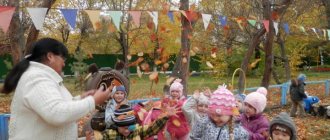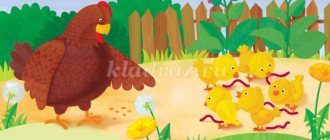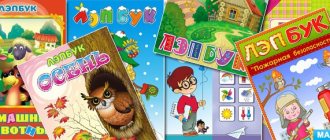Card index of summer walks in the 1st junior group
SUMMERCARD 2
1.
Observation of weather conditions.
Target.
Check with the children the weather conditions: fine day, hot, warm, warm breeze blowing.
2.
Game exercise: “Jump to your palm.”
Target.
Teach children to jump high on two legs.
3.
Role-playing game : “ Family ”
Goal.
Promote children’s desire to independently select toys and attributes for play, and use substitute items.
4.
D/i: “Find and name”
Purpose.
Develop the ability, following the teacher’s verbal instructions, to find objects and name them, their color, size, shape.
5.
P/n : “ Through the stream .
” Target.
Strengthen children's ability to walk on an inclined board while maintaining balance.
6.
Drawing in the sand with your finger.
"Sun". Target.
Develop children's imagination, strengthen the ability to draw rounded shapes.
7.
Independent motor activity.
Target.
To instill in children a desire to perform physical exercises. walking exercises.
SUMMER
CARD 4
1.
Observation of insects.
Target.
Learn to name: butterfly, beetle, ladybug, behave calmly near insects without harming them.
2.
D/i: “Like a beetle buzzes.”
Target.
Develop auditory perception, develop the articulatory apparatus.
3.
Game exercise: “Jump over the cord.”
Target.
Practice jumping over obstacles.
4.
Labor assignment: rake sand into a pile and transfer it to the sandbox.
Target.
Involve children in performing simple labor actions.
5.
P/n: “Sunshine and rain.”
Target.
Teach children to walk and run in all directions, without bumping into each other, to teach them to act on the teacher’s signal.
6. Telling a nursery rhyme: “Shadows - shadow, shadows...”,
with performing game actions.
Target.
Accompany the reading of a short poetic work with playful activities.
S/d game: “Let’s teach Katya to use a handkerchief.”
Target
. Develop skills in using ind. objects.
SUMMER
CARD 6
1.
Observing the weather.
Target.
Teach children, together with the teacher, to note the state of the weather
/
the sun is shining and it is raining, which passes quickly.
White, light clouds float across the sky .
2.
Game exercise: “Hit the target.”
Target.
Teach children to throw a ball at a target.
3.
Labor assignment:
collect toys in a basket at the end of the walk.
Target.
Teach children to perform simple work tasks.
4.
Individual work on physical education: “Bunnies”.
Target.
Practice jumping on two legs.
5.
D/i: Who came to us.
Target.
Teach children to recognize and name animals, clearly pronouncing the sounds
[m], [b], [m'], [b'],
individual sound combinations, and imitate the voices of animals.
6.
P/n: “Sparrows and a car.”
Target.
To teach children to run in different directions without bumping into each other, to start moving and change it at the teacher’s signal, to find their place.
7.
Independent play activity.
Target.
Encourage children to play together in small groups.
SUMMER
CARD 8
1.
Observing plants blooming in a flower bed.
Target.
Teaches you to admire them, but not to tear them. Fix the names of the parts of the plant: stem, flower.
2.
Game exercise: “Jump into the water.”
Target.
Teaches children to jump off a bench, landing on both feet.
3.
Labor assignment on the site:
watering seedlings.
Target.
Help adults take care of plants.
4.
P/n: “ Airplanes ” .
Target.
Teach children to run in different directions without bumping into each other, and to act on a signal.
5.
D/i: “Moms and children.”
Target.
To consolidate knowledge about poultry and their young.
6.
Narration of the poem by Z. Alexandrova: “Dandelion.”
Target. Consider a dandelion. Introduce children to the beauty of the world around them.
7.
S/r game: “Family”.
Target. Teach children to play together. Develop skills in using ind. objects.
8.
Independent play activity.
Target.
Encourage children to play together in small groups.
SUMMER
CARD 10
1.
Observation of trees and shrubs.
Target:
teach children to distinguish trees and shrubs by appearance and leaf structure. To develop the ability to see the beautiful in life, to admire nature.
2.
Didactic task:
show where the plant’s stem / leaves, branches, flower /.
Target:
teach to distinguish parts of a plant, name their color.
3.
Individual work on PHYS.
Target:
Exercise children in walking on an inclined board and throwing at a distance from behind their heads. To cultivate courage and dexterity in children.
4. Work order:
Rake the sand into a pile and transfer it with a bucket to the sandbox.
Goal:
to teach children to carry out simple work tasks.
5.
P/n: “Carousel”. Purpose:
to teach children to run after each other at different paces, to perform actions in accordance with the text of the game.
6.
Round dance game: “Ah, birch tree, green, curly.”
Target:
develop a desire to listen to a folk song, sing along and perform simple dance movements.
7.
Playing with water and sand: “Catching toys floating in the water with a net.”
Target:
consolidate knowledge about the properties of objects/heavy ones sink, light ones float, a paper boat gets wet, a plastic boat gets wet...
8.
Independent play activity.
Target:
teach children to play together in small groups.
SUMMER
CARD 12
1.
Herringbone.
Target walk. Target:
show the children where it grows. Examine it, pay attention to the parts of the tree: trunk, branches, needles. Make sure the needles are prickly. Make a riddle about the Christmas tree.
2.
Individual work on physical education.
Purpose: to train children in walking on an inclined board. Develop balance.
3.
Labor assignment:
collecting twigs and pebbles in a bucket at the site.
Goal:
to instill in children basic work skills.
4.
P/n: “Bubble” Purpose:
to teach children to stand in a circle, to make it wider, then narrower, to teach them to coordinate their movements with the spoken words.
5.
D/i: “Pick up a window and a roof for the house.”
Goal: to teach children to distinguish sensory characteristics: color, shape, size.
6.
Music-did.
game: “The chicken went out for a walk...” Purpose:
teach to expressively convey the image or character of the game’s characters through movement and facial expressions. Enrich children's motor experience.
7.
Independent gaming room.
Goal: to teach children to play together in small groups.
SUMMER
CARD 14
1.
Observation of a rosehip bush.
Target:
teach children to notice the changes that have occurred with the bush / buds have opened, pink flowers have appeared /, as well as to highlight the characteristic features of rosehip / spiny/. Therefore, you can smell it, but you cannot touch or tear it.
2.
Individual work on physical education.
Goal: to train children in throwing and catching a ball, to develop coordination of movements.
3.
Labor assignment:
watering dry sand from watering cans.
Target:
consolidate knowledge about the properties of sand /dry - pours, wet - molds/.
4.
P/n: “Shaggy dog.”
Goal: to teach children to move in accordance with the text, quickly change the direction of movement, run, trying not to get caught by the catcher and without pushing.
5.
Playing with sand.
Goal: to consolidate the concepts of wet and dry. / Dry sand pours out, you can’t sculpt with it. Wet - easier to pile up, load, transport. You can build a garage or a road for cars from it.
6.
D/i: “Whose dandelion will fly further.”
Goal: to develop the ability to exhale air through the mouth for a long time and smoothly.
7.
Game exercise: “Jump into the water.”
Target:
teach children to jump off a bench, landing on both feet.
8.
Independent play activity.
Target:
teach children to independently select toys for play and use substitutes. Play together, share toys with peers.
SUMMER
CARD 16
1.
Transport surveillance.
Goal: to teach children to recognize and name vehicles on the street. Identify common features /steering wheel, cabin, headlights, wheels/.
2.
Work assignment:
sweep benches and tables.
Target:
involve children in performing basic labor activities.
3.
D/i: “What’s for what.”
Goal: to expand the experience of orientation in parts of one’s own body / head, face, arms, back, etc. /
4.
Game exercise: “ Catch the ball .
” Target:
learn to throw and catch the ball with both hands.
5.
P/n: “Hen and chickens.”
Target:
teach children to crawl under the rope without touching it, and to be careful. Teach to act on a signal, not to push other children, to help them.
6.
Playing with water: “Fun fishing”.
Goal: to consolidate the ability to use a fishing rod, develop an eye, quick reactions, and create a joyful mood.
7.
Drawing with crayons on the asphalt: “Rain.”
Target:
continue to teach children to draw broken vertical lines.
8.
Independent play activity.
Target:
teach children to play together in small groups, teach them to share toys, and not quarrel.
SUMMER
CARD 18
1.
Observation of the sun.
Target.
Form the idea that when the sun is shining, it’s warm outside. Maintain a joyful mood.
The sun looks through the window
He looks into our room.
We clapped our hands
We are very happy about the sun.
2.
Work order.
Collecting dry grass on the site. Target.
To instill in children a desire to work and enjoy the work they do.
3.
D/i: “Find a couple” Purpose.
Teach children to classify objects by color/shape/.
4.
P/n: “Cat and Mice” Goal.
Run without bumping into each other.
5.
P/n: “Get into the circle.”
Target. Improve your ability to operate with objects. Learn to hit the target, develop your eye and dexterity.
6.
Individual work on PHYS: “Gate”.
Target. Exercise children in crawling under an arch.
7.
Finger game: “The horned goat is coming...”
Target . Development of fine motor skills of the hands.
8.
Independent play activities with external material.
Target. Teach children to independently select attributes and substitute toys for games.
SUMMER
CARD 21
1.
Observation: pedestrian path - transport /evening/ Purpose.
To consolidate knowledge about the rules of behavior on the street, to develop attention and spatial orientation skills. Explain to children that they are pedestrians and must strictly follow traffic rules, move only on pedestrian paths / sidewalks /. Where should we go. How they should go. /Slowly, don’t shout, be attentive, listen to the teacher/. Who walks on the sidewalk. Is it possible to run on the sidewalk? Why.
Today I am a pedestrian. I have a leisurely pace.
There are no wheels and no steering wheel, There is earth under my feet.
I don't push anyone, I don't overtake anyone,
I'm going to kindergarten, They'll say: baby pedestrian
He's going to kindergarten right.
2.
Outdoor game: “Sparrows and a car.”
Target.
To teach children to run in different directions without bumping into each other, to start moving and change it at the teacher’s signal, to find their place.
3.
Choir game: “We are funny guys...” Goal.
Learn to run in a straight direction, to see someone running in front and next to you.
Develop the ability to navigate in space, coordinate your actions with the actions of other children. We are funny guys, We love to run and play,
Ball, try to catch us. One, two, three - catch up.
4.
Labor assignment: cleaning up sticks and pebbles on the site.
Goal: to teach to work together, to receive satisfaction from the work done.
5.
D/i: “It’s possible or not.”
Target. Continue to teach children the rules of safe behavior with dangerous objects.
6.
D/i: “Family”.
Target. Continue to consolidate children's knowledge about family members: names. Family relationships. Create a feeling of love and care.
7.
Individual work on physical education.
Exercise: “Catch the ball.” Goal: learn to catch and throw a ball with both hands.
8.
Independent play activity.
Goal: to teach children to group together in groups of two or three to play together.
SUMMER
CARD 22
Observation of the driver's work /day/
Target:
introduce the work of a driver. Foster a positive attitude towards adult work.
While walking, pay attention to the grocery car and invite everyone to come closer to it. Who drives the car? Meet the driver. What they brought to kindergarten. How to drive a car. After the story, walk around the car and examine it. The work of a driver is difficult and complex, but people everywhere need it.
P/i “Locomotive” Purpose:
learn to move at different tempos, change direction, convey the characteristic movements of birds and animals, and practice pronouncing sounds.
Sedentary game “On a narrow path”
Target:
learn to step from circle to circle /drawn in chalk on the asphalt/.
Work order: sweep sand from benches.
Target:
to accustom children to basic labor actions, to bring the work started to the end.
Individual work on PHYS. Exercise “Bunny” Purpose:
train children to jump on two legs and move forward.
D/i “What color do we have” Purpose:
teach children to name items of clothing and their color. Develop attention.
Playing with sand. Making pies and cookies using molds. Target:
show the properties of sand / you can make cookies from wet sand /.
Independent games with external material.
Goal:
to teach children to independently select attributes and substitute toys for games.
P/i “Sparrows and the car”
teach children to run in different directions without bumping into each other. Start moving and change it only at the teacher’s signal, find your place.
Imp “Along a narrow path...” Objective:
teach to walk on the cord calmly, slowly, without fear.
Job assignment: cleaning up trash on site. Target:
develop the ability to perform simple work actions. Foster a sense of responsibility.
P/n “My funny ringing ball”
teach children to jump on two legs, listen carefully to the text, and catch the ball only when the words are spoken.
Games with water: “Dives”. Target:
fix the properties of objects. /Show that small ping pong balls do not sink, but jump out of the water/.
Independent play activity with external material Purpose:
teach children to independently select attributes and substitute toys for games.
MAGAZINE Preschooler.RF
Planning summer outings for young children.Dear colleagues, preschoolers, dear parents!
I bring to your attention specially selected material for conducting summer walks with young children from 9 months to one and a half years, both in a preschool institution and at home.
Walking plays an important role in the development, education and health of children.
Each walk includes observation, movement development and hardening. Texts of poems and games are selected for each walk. For convenience, all material is divided into cards, which has its advantage. The card index allows you to reuse the accumulated material, adjusting it if necessary.
Long-term planning of summer educational and health work with children from 9 months to one and a half years.
Examples of walks for one-year-old children.
Theme . ”
Target. Familiarization with the elementary properties of water.
Tasks.
Introduce the elementary properties of water (warm - cold, flows, pours, you can splash).
Development of tactile sensations based on actions with water.
Cultivate positive emotions.
Equipment and materials: warm and cold water, watering can, flower pot.
Progress of the walk.
1. The child is sitting in a stroller.
Mashenka, Masha, our little one. Masha went out for a walk, Mashenka will go for a walk, Mashenka will play.
- And we will play with some water. Where's the water? Let's go look for some water.
We lead the child along the path to the fountain.
The legs walked - stomp, stomp, stomp, Straight along the path - stomp, stomp, stomp. As soon as we go, we go - clatter, clatter, we'll quickly get to the stream - clatter, clatter.
2. We arrived at the fountain.
We know, we know, yes, yes, yes,
Where is the water hiding here?
- Here's some water! Dip the child's hands in the water, move them around in it, pat the water, splash it, wash the hands, wet the nose, forehead, cheeks. All actions should be accompanied by comments. The water in the pool is cold, but the water in the bottle is warm. Warmed up in the sun.
From the water, from the water Everything sparkles with smiles. From water, from water, flowers and birds are more cheerful.
Masha washes herself and smiles at the sun!
— People drink water, and birds drink water, and flowers drink water. Let's give the flowers water; to do this, fill a watering can with water and pour it on the flower. Flowers will thank us. And we will say thank you to the water. Goodbye, water, it’s time for us to leave.
3. Hardening. Now let's ride in a stroller and enjoy the warm rays of the sun. Air-sunbathing, playing with water.
Theme "Bird" .
Purpose of the walk. Bird watching.
Tasks.
- Introduce the baby to the bird, its appearance and habits.
- Develop the baby's general motor skills based on the song.
- Foster the need to communicate with adults.
Equipment: toy bird, seeds, plate, handkerchief.
Progress of the walk.
Adult:
What a good day it is: A light breeze is blowing, the rays of the summer sun are so pleasantly hot... (A. Shibaev)
- Katenka went out for a walk, Katenka will play and, of course, watch. And Katya will watch the bird. Where is the bird? Let's go look for her.
The toy bird is hidden under a scarf. We lead the child, supporting him by the arms, to the handkerchief, pull the handkerchief, a bird appears, the child rejoices.
- Here comes the bird! Let's take a look at it! The bird has a head, beak, wings, tail, and legs.
Using the child's hands we trace all parts of the bird's body.
— The bird can fly. (I show how she flaps her wings.) Jump. (I show how she jumps from branch to branch.) She pecks at the grains. Let's feed the bird. Using the child’s hands, we pour a little seeds onto a plate, tilt the bird and imitate feeding, while saying: peck-peck-peck.
- Furr, the bird flew off, sat on a branch, and will watch Katya play.
Joint movements according to the lyrics of the song:
Oh, the birds were flying, small birds. (We wave our arms.) Everyone was flying, everyone was flying, flapping their wings. (We wave our hands.) We sat down on the path and ate the grains. (We clap the legs.) Peck, peck, peck, how I love grains. (We tap on the palm with our finger.)
Let's clean the feathers to make them cleaner. (We stroke the wrist with our palm.) Like this and like this, so that they are cleaner. (We stroke the wrist with our palm.) We jump on the branches so that the children can be stronger. (Take the child under the arms, jump.) Jump-jump, jump-jump, jump along the branches. (Take the child under the arms, jump.)
Now you can watch a real bird.
— While we were playing, the bird flew away and it’s time for us to go for a walk.
The walk ends with taking an air-sun bath.
Theme : “Oh, what balls...” .
Target. Development of visual perception.
Tasks.
- Develop visual perception of objects that differ in size and texture.
- Develop hand motor skills through actions with objects.
- Cultivate a feeling of joy.
Equipment and materials: a jar for soap bubbles, air balloons with a diameter of 30 cm, rubber balls with a diameter of 15-20 cm.
Progress of the walk.
Adult:
— Winnie the Pooh bear came to visit us, he really wants to play with you. Let's teach the little bear to play with balls.
1. There are 4-5 balloons in the clearing. The adult draws the children's attention to them.
- Look at the balls here, let's touch them. Round balls, light, and how big they are.
Children take the balls, hold them in their hands, shake them, lift them up, lower them down, clasp them with both hands, and press them.
Sharika, they gave us balloons! Red and blue ones were given to the kids. We raised the balls above our heads, Red and blue balls danced!
— And Winnie the Pooh once rose so high (raise the ball with the toy high above his head), and became like a cloud and sang a song:
I'm a cloud, a cloud, a cloud,
And not a bear at all...
- Help me get the teddy bear! (Children jump and raise their hands up.)
- Well done, you helped the bear cub go down!
2. I have a jar for soap bubbles.
- There are also balls hidden in the jar, let's see what kind of balls are there? The teacher takes a jar of soap bubbles and blows them.
Be careful of bubbles! Oh, what! Oh look! They swell and shine! They take off and fly!
- These are soap bubbles. Bubbles are small balls. Catch them! Bang! The balloons are bursting, there is no way to catch them! Bang! Yes, bang! (Children run and catch balls.)
Let the children try to inflate the balloon themselves.
3. There are balls in the box.
- These are balls. They are round, large, strong, elastic, and also look like balls.
We feel the ball with our hands, throw it up, hit it on the floor, catch it, throw it.
You catch my bright ball and give it back, don’t hide it! Ball, jump, take your time, and make the kids laugh!
Bottom line.
“That’s how much fun we had: playing with balloons and balloons, blowing and catching soap bubbles.” Mishka really enjoyed playing with you, but it’s time for him to go home. Say goodbye to Winnie the Pooh!
The walk ends with an air-sun bath and barefoot walking.
| Next > |
